A-26 Invader Units of World War 2
Overview
This book, by Jim Roeder, all around is a good addition to an Invader enthusiast's library. Overall, it paints a good picture of the background and development of the Invader and its use in WWWI, specifically. The book is thorough and thoughtful and logically arranged. It covers many aspects of the Invader that are of interest to the general reader. My main criticism of this work is that anyone who is attempting to use this book as a source for serious historical research approach it with a grain of salt as there are a couple of errors throughout the book. To be clear, I am not putting blame on the author for these errors directly, as publishers are often known to edit and change things without the authors knowledge. These errors aren't the kind of thing that would detract a general reader from enjoying the book, but they may be small obstacles in research-based interests. In the sake of trying to point out these issues, I have made a list of the errors in the book below, along with the corrections.
Versions & Editions
The book I have in my collection is the 1st Edition of this book, copyright 2010. It features the plane "Sugar Baby" on the cover. I have seen a 2nd version of this cover in one place, but I have not seen a second edition of this book, so I am unsure if this other cover was a prototype mockup or an intended 2nd edition. Every book seller that carries the book only seems to have the 1st Edition available.
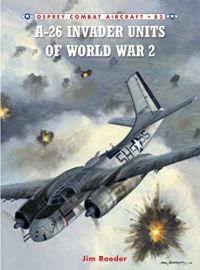
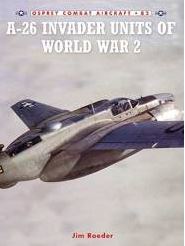
Corrections
I will be going through the book in order by page. Many of the corrections are with the photo captions, and I will try to point these out specifically.
For ease of use, I have used the same section headers that the book uses.
Preparing the Invader
Pg 6 - Bottom photo - just a minor correction here. What is being referred to as "engine nacelles" are actually "engine cowlings".
Pg 7 - Top photo - The caption implies that the Invader was the first American medium bomber to feature a single pilot, but the Invader's immediate predecessor, the A-20 Havoc/Boston also featured a single pilot.
Pg 8 - Bottom photo - The caption talks about the "heavy framing" of the window reducing visibility. However, the cockpit style shown here is the Generation 2 cockpit that was introduced as a way to improve visibility. (He references this in the top photo caption on Page 9). The "heavy framed" window that reduced visibility was this, Generation 1 cockpit canopy.
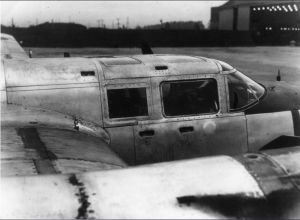
Pg 9 - "The introduction of a new component such as this inro an active production line could easily result in serious disruption, so it was not until I December 1944 that new aircraft fitted with the clamshell canopy started to leave the Douglas plants. Previous publications on the A-26 have stated that the new clamshell canopy was retrofitted to earlier Invaders fined with the original flat style canopy. However, the author has conducted extensive research in company literature and maintenance manuals, and pored over hundreds of production line photographs, and none have revealed evidence to support this belief. Interviews with air- and
groundcrews have failed to confirm this either. The reason for this apparent error may be, quite simply, a case of mistaken identity due to a confusion of terms. That is, confusing the revised flat top canopy with the new revised bubble canopy. The revised flat top panel could easily be installed on aircraft completed before the introduction of the revised bubble canopy, groundcrew simply removing the screws that held the original framed canopy in place and then replacing it with the flat top panel. This switch could be accomplished without the A-26 having to be taken out of service. The clamshell canopy could not be installed on aircraft completed with the flat top canopy, however, as the redesigned component was higher at the front than at the rear and the angle of the front windscreen was altered. To even attempt to replace the flat top canopy with the revised bubble one would have required time-consuming and extensive metal and Plexiglas work far in excess of any potential benefit. There are examples of the A-26 Invader built with the original flat top canopy still in existence today, never having had their canopy assemblies replaced."
The book says the clamshells left Tulsa during December 1944, however, the first plane equipped with a clamshell canopy was 43-22602, and it wasn't accepted into service until mid-January 1945.
The book claims that the old flat top styles were not retrofitted with clamshells. It also states that no one ever talks about this being true, and that there are no photos supporting this, and that there are still examples of flat tops today, so based on all of this evidence, clearly it must be false and that the two canopies could not have been compatible. Now, the book is focused on WWII, so I will start by saying that during WWII it was exceedingly rare for these top canopies to be retrofitted onto flat top canopies. If the examination is limited in research only to that era, and only to those units, then I can understand why the book may state that was impossible. However, to take something that did not occur during WWII and then extrapolate that out to mean that it was possible at all is false.
Why are there still flat top examples today if the planes were retrofitted? That's because immediately after WWII many of the A-26s were placed in surplus and either sold off or scrapped. Civilians and private corporations purchased some of those, which included flat-top canopy models. Why retrofit something that wasn't going to be used? The book further goes on to state that there was not enough potential benefit for the modifications. This is a misstatement. The potential benefit is perhaps the biggest, most important benefit of all - crew safety. The flat top canopies were death traps. They were difficult to open during an emergency, difficult to keep open because wind pressure kept wanting to push them closed, and even if you could get them open, the pilot had to climb all the way over to the navigator's side in order to bail out. If the plane was rolling during its descent, the centripetal forces made this task exceptionally difficult in the best-case scenarios. With the clamshell design, both panels could be ejected, and the crew had a much easier time of escaping the plane.
So, now we've answered why some flat top examples could exist, even if the planes were retrofitted. But what about the retrofitting? Is there any evidence for this? Yes, there is. There are more than a dozen photos showing very early model Invaders (Pre-Block 25) that have been retrofitted with clamshell canopies. In fact, one of the planes arrived in Korea with a flat-top and after she was assigned to the 13th Bomb Squadron, the maintenance section's log indicated that they were going to "perform surgery" on the ship, and after that she was a clamshell canopy. So, not only could the canopies be swapped and retrofitted, but they could also be swapped in the field without sending the plane back to a depot.
This photo shows 43-22343 at Iwakuni AB in 1951 while in the service of the 13th Bomb Squadron, 3rd Bomb Group. She was built as an A-26B-15 Invader, so she was outfitted with the Generation 2 flip-up canopy, which can clearly be seen in the photo. The plane was the squadron hack and was called "the Point" due to her tail markings.

This photo shows "The Point" (43-22343) sometime in early 1952. She had her nose swapped out for a glass nose while serving with the 13th, but still retains her Gen 2 canopy.
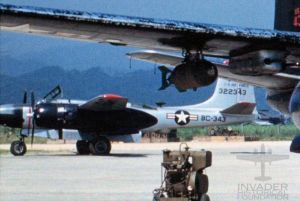
This photo from late 1952 shows "The Point" (43-22343) after her "surgery". She can be seen wearing the same glass nose from the previous photo, but now she is also wearing the Gen 3 clamshell canopy.

Pg 10 - "A further misconception is that the Invader could switch from being a level bomber to a ground strafer simply by replacing the Plexiglas nose with the six- or eight-gun solid nose. No evidence to support that belief has been found to date. Indeed, to attempt such a task in the field would have been far too time-consuming for the groundcrew involved. With the underwing O.50-in gun pods (two weapons per pod) or wing-mounted guns (three within each wing), even the glazed-nosed A-26C could be used for strafing missions - life for the bombardier during such strafing attacks would probably have been quite interesting!"
This is another example of an error in factual details. Again, if the examinations were strictly limited to only WWII operations, then it can be understandable that the book might make this claim. I have found no evidence of WWII planes having their noses swapped operationally in the field. Although, even the book itself points out in Page 8 "the Tulsa plant produced A-26C nose sections as field kits for units to install on existing A-26Bs. As many examples of the latter were fitted with a C-model nose, the serial number is the only certain way to determine if an A-26 was indeed built as a C-model or was a B with a C nose added as a field modification." This directly contradicts the book's own statements. On Page 10 the book says that they could not swap the noses, but on Page 8 the book says that Tulsa specifically built kits for the noses to be swapped. The book further mentions a nose swap kit with an 8-gun nose on Page 11. Which is it, can the noses be swapped, or can they not? Giving the book the benefit of the doubt and saying that the book meant strictly that the noses could not be swapped out in the field, but could be swapped in a repair depot, the book would still be incorrect. Beginning with Production Block 10 the B models were fitted with the 6-gun general purpose nose. This nose was specifically designed to be swappable, even as stated within the Pilot's handbook.
While there is little evidence of planes having their noses swapped in the field during WWII, there is plenty of evidence that this occurred with great frequency in Korea. Sometimes the same plane is seen wearing different noses in multiple photographs. I even have a picture of a crew doing a nose-swap. The technical and maintenance documents from Korea state this the noses could be swapped out in about 4 hours. To directly refute this claim, it's not a misconception. A plane could return from a mission as a glass-nose model in the morning, have the nose swapped out for a gun nose model, and then take to the skies again that night as a strafing plane. Typically, this did not need to happen, but it was definitely possible, and did happen on some occasions. More typically, the planes were fitted with different types of noses based on the squadron's use of tactics and availability. At one point, the 13th Bomb Squadron commander traded every glass nose plane he had to the 8th Bomb Squadron in exchange for their hard nose planes. The planes that he couldn't trade, he ordered nose swaps done. In the 13th Bomb Squadron alone, there were 51 aircraft that had their noses swapped from gun to glass or vice versa.
This photo is perhaps the most telling. Here, the ground crew of a 17th Bomb Wing plane replaces the plane's broken nose after a landing accident during the Korean War. Very little was needed in the way of special equipment and the nose could easily be swapped in the field. This was one of the major modifications beginning with Production Block 10. Douglas Invader schematic 5202513 shows that there are 8 attachment points that connect the nose to the fuselage. T.O. 1B-26B-2-2, Section III, Paragraph 3 provides the ground crew with instructions on how to repair, remove, and install the various noses for this aircraft.

Pg 10 - Text - "Aside from the A-26B's solid nose containing six 0.50-in machine guns, additional forward firepower was initially provided by single underwing pods housing a further pair of O.50-in machine guns. These
added considerable drag to the aircraft, however, reducing its top speed by 25 mph. This problem was rectified when Douglas began producing aircraft with three O.50-in guns mounted in the leading edge of each wing, the barrel of the center weapon projecting out further than the other two. This arrangement increased the Invader's firepower without adversely affecting its airspeed."
There were two underwing gun pods for each wing, providing a total of 4x additional .50 caliber machine guns. The arrangement of the internal wing guns was not consistent. The Douglas Invader had no less than 6 different versions of the wings produced, labeled A through F. How the guns sat depended specifically on which wing was installed. The first internal guns, for example, all sat flush and even with each other. The second set slanted outward with the innermost guns protruding the most. The third revision features the center gun protruding in the manner that the book describes.
This photo shows that the internal wing guns mounted in the Type A wing were arranged with all of the barrels in line with each other.
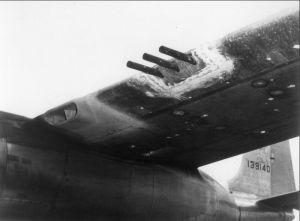
Combat Evaluation
Pg 12 - "Another less sinister criticism was that the aircraft's cruising speed was considerably greater than that of the A-20, which meant that both types could not be used in the same combat formation."
This is not strictly true. Beginning with mission #159 on 17 Nov 1944, the 416th Bomb Group started flying combat missions with a mix of A-20s and A-26s. This mission had 6x A-20Ks and 28x A-26Bs. In total, 39 of the combat missions that were flown by the 416th's Invaders were flown with a mix of A-26s and A-20s (either K or J models). The 3rd Bomb Group's unwillingness to fly Invaders and Havocs together did not mean that it wasn't possible, as other units did it routinely to great effect.
Pg 12 - "The Invader's delayed arrival in the Pacific has often been misconstrued as a complete rejection of the A-26 by the 3rd BG, which was nor the case. The intended assignment of the aircraft to the Fifth Air Force was
nor received favorably by its commanding officer, Gen George Kenney, who stated emphatically that he did not want the A-26 as a replacement for any aircraft for any reason. This comment was not made because of any
major shortcomings with the Invader, bur was based on Kenney's firm belief that the A-20s and B-25s then equipping his groups were more than sufficient for their assigned purpose."
Yes, it is true that General Kenney was the primary reason that the Invaders were delayed in arriving in the Pacific. However, to say that General Kenney's decision had nothing to do with the 3rd Bomb Group or the shortcomings of the aircraft is not accurate. Capt. Greene, Capt. Cook, and 1Lt Shook of the 8th and 13th Bomb Squadrons evaluated the A-26 and provided a report to General Kenney. They lament the poor visibility against ground targets, they lament the poor visibility in searching for ship targets, they lament that poor visibility will hamper formation flying, they lament that the plane is "not as fast as expected" and that the range was only slightly better than the A-20. They said that the plane would be great for medium bombing, and they were happy with the weapons loadout and crew space. Otherwise, they had very little to say about the plane that was nice. It is certainly this report which informed General Kenney's decision. For a commander to make such an arbitrary objection without taking these points into consideration would have been folly. This is further proved by the fact that Gen. Kenney dispatched an aide to Washington with a list of not less than 25 specific recommendations that they wanted to see on Invaders in the Pacific. Douglas did custom-build specific Invaders for the Pacific, often called "General Kenney Specials", based on this list. The fact that there was a specific checklist of things that General Kenney wanted based directly on the observations and report of the 13th Bomb Squadron crew strongly suggests that they made a refusal of the aircraft. The book points out that the first unit to use the A-26 in the Pacific was the 319th Bomb Group, but he fails to mention that these planes were all General Kenney specials and not the stock Invaders being used in the ETO.
Below is the report from the 8th Bomb Squadron.
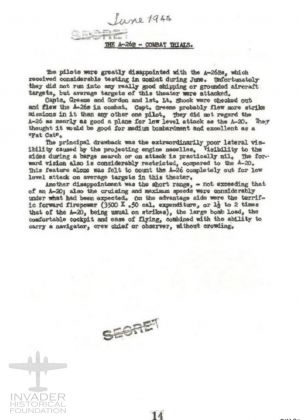
This report from the 13th Bomb Squadron's June 1944 Monthly History summarizes their feelings about the A-26.
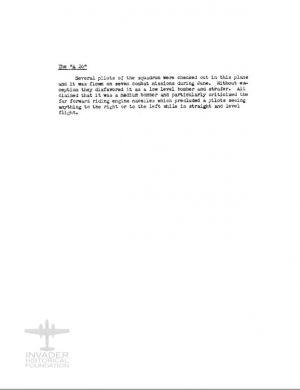
Pg 13 - Bottom photo - "Although this A-26B displays the markings of the 386th BG, it is actually one of the 18 Project Squadron aircraft attached to the unit in August 1944. This photograph was taken while the 416th BG was converting to the A-26. During the initial conversion training period, Project Squadron aircraft retained the 386th BG markings used during the evaluation missions."
Also in the text: "The crews reported to Hunter Field, Georgia, to pick up 18 brand new Invaders (12 B-models and six A-26Cs) before flying to Prestwick, Scotland, in early August 1944."
The things here are not egregious, they are just technically wrong. For example, there is no evidence that Project Squadron actually had 18 aircraft (We will be talking about them a lot). They were requested to have 18 aircraft - 6x C models and 12 B models, but that's not proof that they received 18 aircraft. At most, I can prove 16 planes. Secondly, the initial evaluation period was not when the 386th pilots were trained. The Project Squadron was attached to the 386, not assigned to it. They had their own crews. Their job, in Aug and Sep 1944 was not to train new crews, it was to conduct field evaluations on the Invader's effectiveness in combat. After those evaluation missions were completed, then Project Squadron was assigned to retrain pilots, but they did not start with the 386th as they were not the first to convert. Project Squadron was assigned to the 416th Bomb Group in late September, and they were the first unit to be trained on and receive Invaders.
Pg 16 - 2nd Photo - "The Project Squadron suffered a high attrition rate due to undercarriage failures whilst in the ETO. An aircraft such as this could be repaired, however."
The plane photographed is serial number 41-39343. This plane's IARC card indicates that it was accepted into the USAAF inventory on 28 Oct 1944 and then it was assigned to the 9th AF (GLUE) on 14 Nov 1944. Accident reports reveal that this plane suffered a landing accident at Beaumont, France on 18 Mar 1945 while assigned to the 555th Bomb Squadron, 386th Bomb Group. The pilot was David M. Susswein. This makes it very clearly not a Project Squadron aircraft.
Pg 17 - Photos - "Below and bottom: The nose gear of this A-26B collapsed on landing after a training mission at Wethersfield on 18 October 1944. This is one of at least three landing gear failures known to have occurred on the
same day and at the same location."
Obviously, the nose gear collapsed, but there are some inaccuracies and context missing. First of all, there were not 3 accidents on the same day at the same location. This plane, 41-39183, crashed on 15 Oct 1944 at field A-55. The reason for the crash was an emergency landing in a field due to inclement weather (cloud ceiling dropped below 300 feet). The wheel hit a rut and collapsed under the weight. 2Lt Stanley H. Sheley was the pilot.
The second accident at A-55 on 15 Oct 1944 involved plane number 41-39196, when the pilot was trying to descend out of the clouds into clear weather and struck a tree, then the side of a mountain and all hands were lost. It had nothing to do with a nose gear.
The next accident at A-55 was on 18 Oct 1944, which did involve a landing gear, but it was the nose gear. 1Lt Barton D. Stebbins was piloting plane number 41-39207 during taxi. The sunlight obfuscated the pilot's view of the runway, and he did not see a large hole that was being repaired. He drove the plane into it and the right main gear took the brunt of the impact, breaking the shock and causing the gear to collapse.
While there were three accidents at the same based in a short period of time, they were not on the same day, nor caused by the same issue.
Into Action
Pg 21 - Photo - "A ground crewman refuels a 416th BG A-26 at Melun. It is not clear why there is only one gun in each underwing pod, although such an arrangement was seen in photographs of several 416th BG Invaders."
This isn't necessarily a correction, but rather an explanation. To save weight, the Invaders were not ferried with the underwing gun pod armament in place. Since the .50s were standard guns used on many planes, the planes only came with the cowlings, but some units experienced a wartime shortage of guns and in an effort to keep supplies available, they fitted the underwing pods with only a single gun instead of two.
Invaders to the Fore
Pg 41 - Photo - "Maggie's Drawers was yet another A-2GB assigned to the 41Gth BG whose serial remains unidentified."
Maggie's Drawers was plane serial number 41-39360, assigned to the 671st Bomb Squadron, 416th Bomb Group. She flew with fuselage code 5C-L.
Pg 42 - 2nd Photo - "Lt Johnson's Invader was not the only A-26 written off by the group on 21 February, as this A-26B-20-DL from the 671st BS crashed heavily on landing too. The force of the impact with the ground twisted and
broke the nose gear clean off, while the left main gear leg was driven up through its wheel well. Both pilot and gunner survived the crashlanding unscathed."
Johnson's plane crashed on 21 Feb 1945, returning from mission #209. The plane captioned here crashed on 22 Feb 1945 returning from mission #210, these were one day and then the next day, not on the same day. Furthermore, pilot Hartwig M. Van Norden's plane, 41-39208, was not written off as claimed. She was repaired and put back into service. She returned to the US on 6 Sep 1944. She spent a number of years in storage at Hill AFB and then was assigned to the Air National Guard in 1952 and served with that group until 1955.
More Units Convert
Pg 72 - Top photo - "Having lost a substantial portion of its left wing to a direct flak hit during its bomb run, an unidentified A-26B from the 642nd BS, 409th BG plummets earthwards."
This plane is well known. This is D6-L, which makes it 43-22359 of the 642nd Bomb Squadron, 409th Bomb Group. The plane was lost with all hands on 21 Mar 1945 just moments away from dropping bombs on her target. The missing air crew report says that the she took a direct hit from flak and spun as she fell, no chutes were seen. The crew was 1LT Donald J. Cotton (Pilot), Ssgt Don E. Nord (Navigator), Ssgt Loring E. Lord (Gunner). In 2018 the remains of Cotton and Nord were identified and their bodies were taken to Margraten Cemetery for proper burial. Ssgt Lord's remains have not yet been located or identified.
Pg 72 - Bottom photo - "This 386th BG A-26B was forced to make an emergency belly landing at Melun (then home of the 416th BG) on 25 January 1945 after it suffered flak damage. The bent propeller blades indicate that both engines were still running when the aircraft touched down."
This is a not a 386th plane. The markings all wrong for that unit. Further research into the serial number and accident reports reveal that this is 41-39295 of the 640th Bomb Squadron, 409th Bomb Group.
Pg 88 - Bottom photo - "A formation of 3rd BG A-26Bs is pictured in flight over Japan during the winter of 1945. The 3rd BG did not convert to the A-26 until after the end of World War 2 in September 1945. The group's planes were built without the lower gun turret."
This caption implies that the 3rd did not receive any Invaders until after WWII. However, the 3rd Bomb Group had at least some A-26s that were used in combat as early as June 1945 against targets in Formosa.
Pg 90 - "The initial prototypes of the A-26 were delivered in what was then the standard finish of olive drab upper surfaces over neutral grey undersides. Production aircraft were delivered in natural metal finish devoid of any paint apart from required (or desired) markings."
This is not entirely correct. Production Block 1-DL and Production Block 2-DL were both manufactured with the same OD green camouflage as the prototypes. This camo was not removed until Production Block 5. The camo was then reintroduced in production models that were purpose built for the Pacific beginning with Production Block 51.
Pg 91 - "No photographs of the A-26s us d by the 3rd BG for the combat evaluation undertaken in June 1944 are known to exist. It is reported that they were flown in olive drab and neutral grey camouflage. It is not
clear if the aircraft delivered to the 3rd BG in 1945, which arrived wearing the overall olive drab finish, were painted at the factory or one in the field with the unit. The 3rd BG applied markings to its Invaders that were similar to those displayed on its A-20s. Each squadron added its own colour to the tip of the tail, trimmed in white. A single large white letter was applied to the tail blow the squadron colours, which were a follow 8th BS yellow, 13th BS red, 89th BS green and 90th BS white."
There is a bit to unpack here. The book states that the PTO evaluation planes were Olive Drab and that no known photos of them exist. We know from the serial numbers that these planes were Block 5 planes, which meant that they were unpainted at the factory. And while the overall paint scheme he describes was adopted by the 3rd Bomb Group by the end of WWII, the evaluation planes were not painted that way, they were unfinished aluminum trimmed with the red paint of the 13th BS. We know this because photos of all 4 aircraft do exist. None of the evaluation planes bore the letters used by the 3rd BG squadrons.
Pg 91 - "At some time soon after receiving the aircraft, the group (319th BG) painted a large black three-digit number in the 500 series above the serial number. It is unclear exactly when this was done as photographs exist of the group's Invaders both with and without these three-digit numbers during the same timeframe."
This was not done by the group. Douglas changed the location of the fuselage codes during the production run at the Tulsa factory. The plane "Iron Project", serial number 44-35281 bears the large 584 on the tail. This coincides with the Douglas fuselage number. Previously this number was applied to the fuselage near Station 0, just forward of the cockpit.